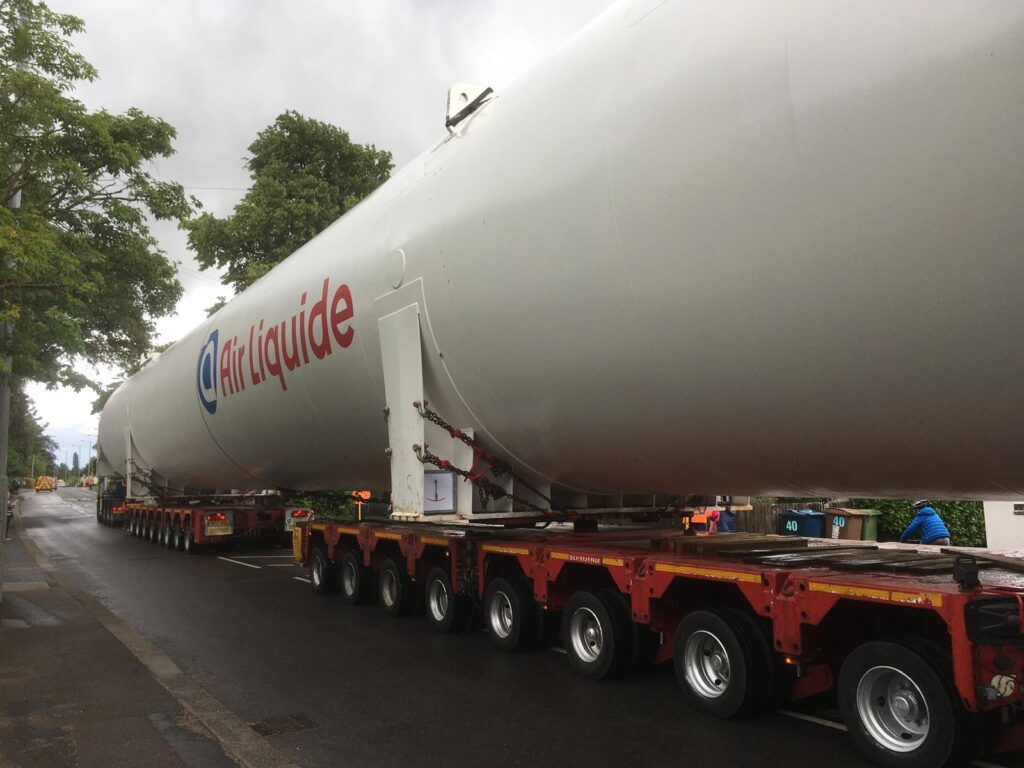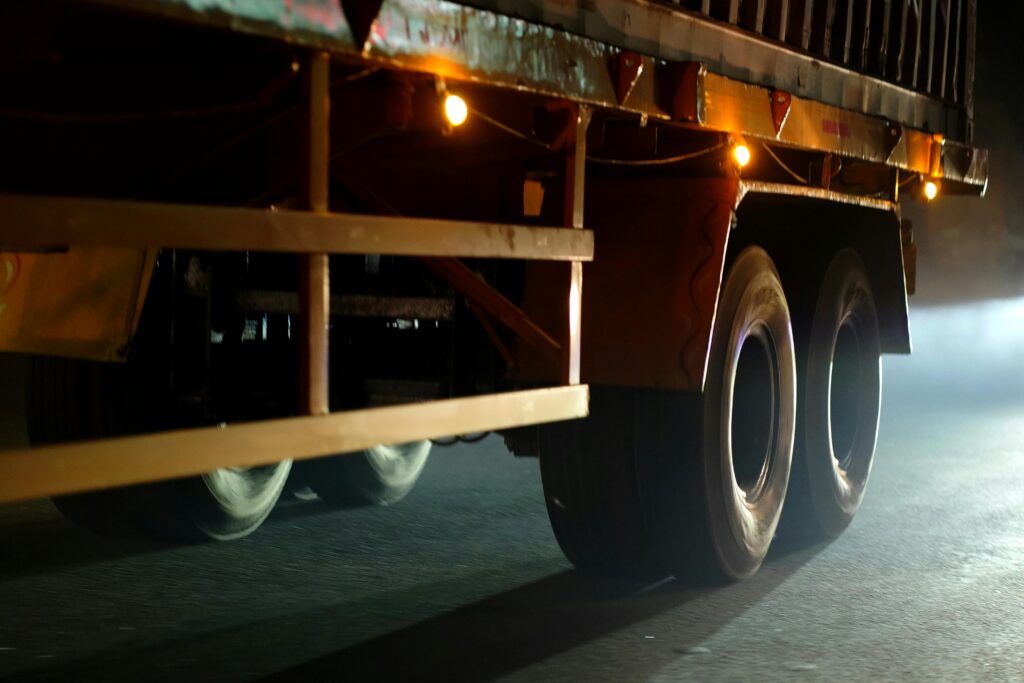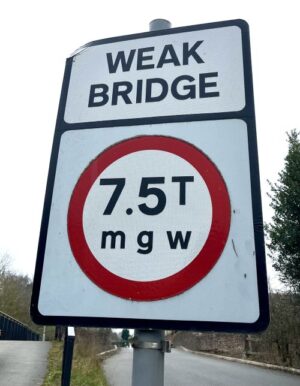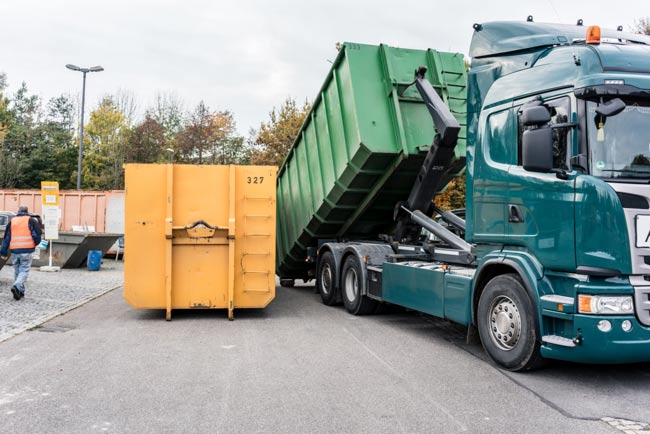Special Types General Orders or STGOs are a set of regulations which allow unusual vehicles to be driven on UK highways. An STGO will indicate which category a vehicle is licenced to operate within. It also will identify the weight of a vehicle and will be clearly visible on the front of a vehicle.

Under normal circumstances a vehicle and its load must not exceed the weight and dimensions contained within the Road Vehicles (Construction & Use) Regulations 1986 and the Road Vehicles (Authorised Weight) Regulations 1988. These regulations are set by the Driver and Vehicle Standards Agency (DVSA). Further details about this legislation are available here.
STGO rules mean that a range of less common vehicles, including some found in the waste management industry, whose design and use prevent compliance with the above regulations, may, in some circumstances, be used on public roads.
Examples of vehicles likely to be used under an STGO are:
- Abnormal Indivisible Loads (AILs) which cannot be divided in to two or more loads to be transported by road
- Mobile cranes specially built or adapted for lifting operations
- Engineering machinery that are moveable and comprise of a motor vehicle or trailer specially built for engineering operations
- Road recovery vehicles which are specifically build for recovering broken down vehicles
What are the STGO Weight Categories?
There are three weight categories of STGOs:
Category 1 – max gross vehicle weight N/A and max category gross weight 50,000kg
Category 2 – D x 7,500kg and max category gross weight 80,000kg
Category 3 – D x 12,500kg and max category gross weight 150,000kg
(where D = the distance in metres between the foremost and rearmost axles of the vehicle carrying the load; or, in the case of articulated vehicles the kingpin and the rearmost axle on the semi-trailer; or, in the case of any other description of combination, the foremost axle and the rearmost axle of the group comprising of all the vehicles in the combination that are carrying a load).
Abnormal Indivisible Loads (AILs)
As mentioned above, an AIL is a load that can’t be divided in to two or more loads for transporting on highways without undue expense or risk of damage and which due to dimensions and/or weight can only be carried by a heavy motor car or trailer or a combination of these which does not comply with the Construction & Use regulations.
Any vehicle that weighs more that 44,000kg, that has an axle load of more than 10,000kg for a single non-driving axle or 11,500kg for a single driving axle, a width of more than 2.9m and a rigid length of more than 18.65m is classed as an AIL.
Normal vehicles should be used where possible and may still be used even with some overhang of the load at the front, rear and both sides. If, however a normal vehicle cannot be used for reasons such as safety a larger vehicle or combination of vehicles should be used subject to the STGO conditions.
STGO Category 1
In order for a vehicle to be classed as STGO Cat 1 it must not exceed 46,000kg with a minimum of 5 axles, and 50,000kg with a minimum of 6 axles. In this category the AW regulations minimum weights apply to axle and the vehicle gross weights. All STGO Cat 1 vehicles must display a “STGO Cat 1” plate to the front of the towing vehicle.
Before an STGO Cat 1 vehicle is to be used on the highways a minimum 2 days’ notice must be issued to highways and bridge authorities about the weight and the police may need to be informed of the vehicles’ dimensions.
The speed restrictions enforced for STGO Cat 1 vehicles are maximum 60mph on motorway, maximum 50mph on dual carriageways and a maximum of 40mph on all other roads.
STGO Category 2
An STGO Category 2 vehicle must not exceed 80,000kg. There are a number of other conditions that apply to the category. Category 2 vehicles must have a minimum of 6 axles, with the combined axle weight not exceeding 12,500kg.
In addition, a vehicle in this category must display the “STGO Cat 2” plate to the front of the towing vehicle. Where an STGO Cat 2 vehicle is to be used, there must be 2 working days’ notice to all relevant highway and bridge authorities. It may also be necessary to inform the police of the dimensions of the vehicle/s.
STGO Cat 2 vehicles are subject to specific speed restrictions. The speed limit on a motorway is 40mph, on a dual carriageway it is 35mps and just 30mph on other roads.
The STGO Cat 2 plate displayed on the vehicle must show the maximum weight recommended by the vehicle manufacturer when travelling at certain speeds. This plate must be marked “Special Types Use” and should show the weights for gross, train and axle weights.
STGO Category 3
STGO Category 3 vehicles can not exceed 150,000kg. They must have a minimum of 6 axles and have a maximum axle weight of 16,500kg.
It is essential that these vehicles display an STGO Cat 3 plate at the front of the drawing vehicle.
Due to the exceptional size and weight of these Cat 3 vehicles, operators must give at least 5 working days’ notice to highways and bridge authorities and as with Cat 1 and Cat 2 vehicles the dimensions may need to be given to the police.
As you would expect, the speed limits imposed on Cat 3 vehicles are even more restrictive. Motorway speed is limited to 40mph, dual carriageway speed is limited to 35mph and a maximum speed limit of 30mph is enforceable on other roads.
STGO Category 2 and STGO Category 3 vehicles must also be fitted with a plate that shows the maximum weight recommended by the vehicle manufacturer when travelling at certain maximum speeds. This plate must be marked “Special Types Use” and should show the weights for gross, train and axle weights.
STGO Offences, Penalties and Vehicle Tax
Failure to comply with the requirements of STGO is not an offence in itself, however, movements covered by STGO are exempted from a number of construction and use rules. As a result, a failure to follow the requirements would render a driver and operator liable to prosecution under C&U (Construction and Use) or AW (Authorised Weight) regulations. This could apply if a vehicle were found to be overladen and therefore exceed weight limits or if it were found to be over width.
Depending on the use of a vehicle, the taxation levels under Vehicle Excise Duty will vary. If an AIL is carried on a vehicle which complies with C&U or AW regulations won’t need to be taxed at the STGO rate unless the load carried is over 4.3m wide and is then covered by the special types rules. Vehicles carrying loads over 4.3m wide but which comply with C&U regulations must pay vehicle excise duty appropriate for special types vehicles.
ESDAL
With the requirement for the various highways and bridge authorities requiring advance notification of a forthcoming AIL journey, and the police requiring notice of a vehicle’s dimensions, the introduction in 2010 of the Electronic Service Deliver for Abnormal Loads (ESDAL) has made life so much easier for operators and the authorities alike.
ESDAL is a stable, reliable and comprehensive system that incorporates an innovative mapping system which companies can use to identify routes and access full details of all those organisations that will need to be notified about the journey before it takes place.
ESDAL also offers the facility for hauliers to check the route for vehicle suitability.
Operators can register to use the ESDAL system for free, with no hidden charges within the programme. For further information simply visit https://esdal.nationalhighways.co.uk/.
What driver training do I need to drive STGO vehicles?
Any driver needing to drive an STGO vehicle must hold a valid CPC (Certificate of Professional Competence) Class 1 licence.
Due to the complexity of driving STGO vehicles and abnormal loads, drivers are often required to obtain additional certifications and training. MHF (UK) Ltd recommends that drivers on STGO vehicles also consider gaining qualifications in the following areas:
- Advanced Driver Training – with a focus on how to hand heavy and/or oversized loads. It includes techniques for manoeuvring, safe driving and load security, emergency procedures and how to deal with potential hazards on the road.
- Escort Vehicle Training – recommended for drivers who also operate escort vehicles. This training covers topics such as traffic management and communication protocols on complex routes.
- Health and Safety Training – including comprehensive training on risk assessments, health and safety regulations and the safe use of equipment and personal protective equipment; highly recommended for all STGO drivers.
- Load Securing Certification – considered essential due to the importance of safely securing abnormal loads. Drivers often need certification in load securing techniques. Abnormal loads can be even more difficult to secure and transport safely.
- Route Awareness – essential before undertaking a journey involving an STGO vehicle. Make sure you are familiar with the planned route, including any specific challenges or restrictions. Consider carrying out dry runs of routes or carrying out a route survey at the very least.
Frequently Asked Questions
What training is required to drive an STGO vehicle?
Drivers of STGO vehicles typically need a Category C (HGV Class 2) or Category C+E (HGV Class 1) licence. Additional training may be required for handling abnormal loads and ensuring compliance with STGO regulations.
What is the STGO category 2 weight limit?
The STGO Category 2 weight limit is up to 80,000 kilograms (80 tonnes), depending on the vehicle configuration and number of axles.
Where can I get more information about STGOs?
More information about STGO regulations can be found on the UK government website or by contacting the Driver and Vehicle Standards Agency (DVSA).
What else should I be aware of when using STGO vehicles?
We would highly recommend that drivers of STGO vehicles are trained in how to safely secure loads. Goods vehicles operating under STGO and Special Order have to follow drivers’ hours and working time regulations.




